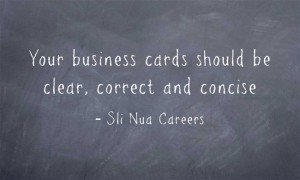Pic source www.pixabay.com
by Liam Horan, Managing Director, Sli Nua Careers

Q: I am a teacher looking for subbing work. I was thinking about printing a business card to hand out when I go to schools. I thought it might help me to stand out. What do you think? Thanks (DR, email).
DEIRDRE MAY, LIMERICK: I am absolutely in favour of business cards for anyone who is offering a service, and teachers are no exception. As a substitute teacher your business card shows you mean just that: business. To a principal you are presenting a strong, positive impression of someone who is professional and organised – two great qualities in any teacher.
So what should your business cards look like? My advice to you would be to match your cards to your CV and LinkedIn profile – it is all part of your personal branding, use the same colours, font and photograph on all three media. A word of warning in relation to font size – the vast majority of the population over 35 are longsighted and have difficulty focusing on objects that are up close; so keep the font size big enough to read without the reader having to put on a pair of glasses.
The card should measure 2″ x 3.5″ and must be simple and concise, forget the gimmicks and remember it is not an art installation. If you do want to be different and practical at the same time, use business cards with a magnetic backing; they can be fixed to filing cabinets or notice boards within easy reach. The real benefit of a business card is that a principal knows how and where you can be reached quickly. Ensure your name, address, email and mobile number are clearly printed on the card. You could also include your teaching registration number, that you are Garda vetted and the year of your graduation.
Last tip: before you distribute your cards, proofread them and, better still, get someone else to proofread also. As much as I am in favour of you sending out business cards, a misspelt word will ruin your best intentions and rather than it being a positive reflection of you, it will be a very poor and shoddy one.
MARY O’BRIEN-KILLEEN, CLAREMORRIS: An excellent idea, I would recommend same. Anything that will make you stand out from the crowd will get you the subbing work. What about putting your photograph on it as well?
 MARK MCDONALD, DUBLIN NORTH: DR, first impressions carry a lot of weight when an employer considers the suitability of an applicant. Using a business card to accompany your CV can work in your favour if you get the basics right. Your business card has one purpose only – to make it easy for a potential employer to contact you. With that in mind, keep it simple with your name (maybe add academic letters BA, HDip, etc), phone number, email address and vanity (shortened) LinkedIn profile address.
MARK MCDONALD, DUBLIN NORTH: DR, first impressions carry a lot of weight when an employer considers the suitability of an applicant. Using a business card to accompany your CV can work in your favour if you get the basics right. Your business card has one purpose only – to make it easy for a potential employer to contact you. With that in mind, keep it simple with your name (maybe add academic letters BA, HDip, etc), phone number, email address and vanity (shortened) LinkedIn profile address.
Don’t overplay your hand on the design of your business card. Keep it clear and professional. Using a business card to accompany your CV won’t guarantee you get to the next stage, but it could possibly raise your profile with the key decision makers.
SIOBHAN O’MALLEY, BALLINROBE: A business card is a very good idea. While the concept of marketing has changed over the years, the practice of exchanging business cards has remained. And for good reason.

